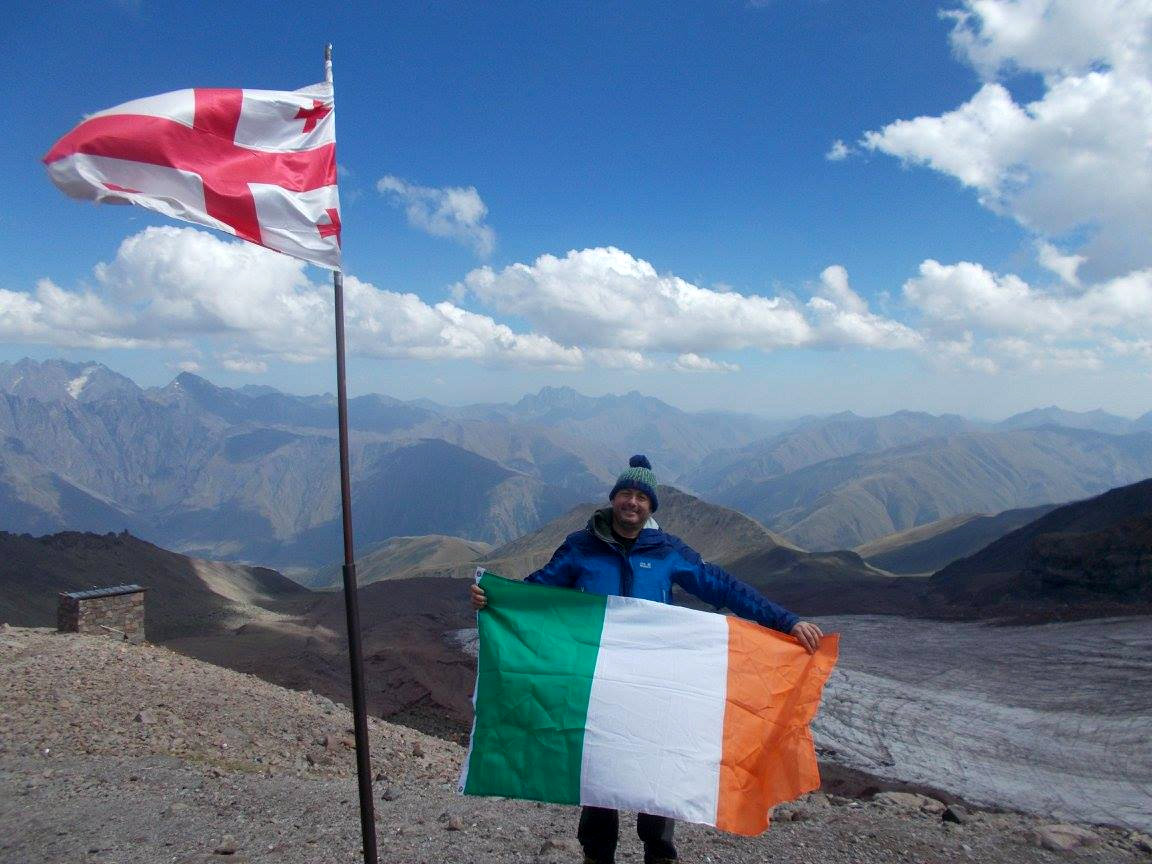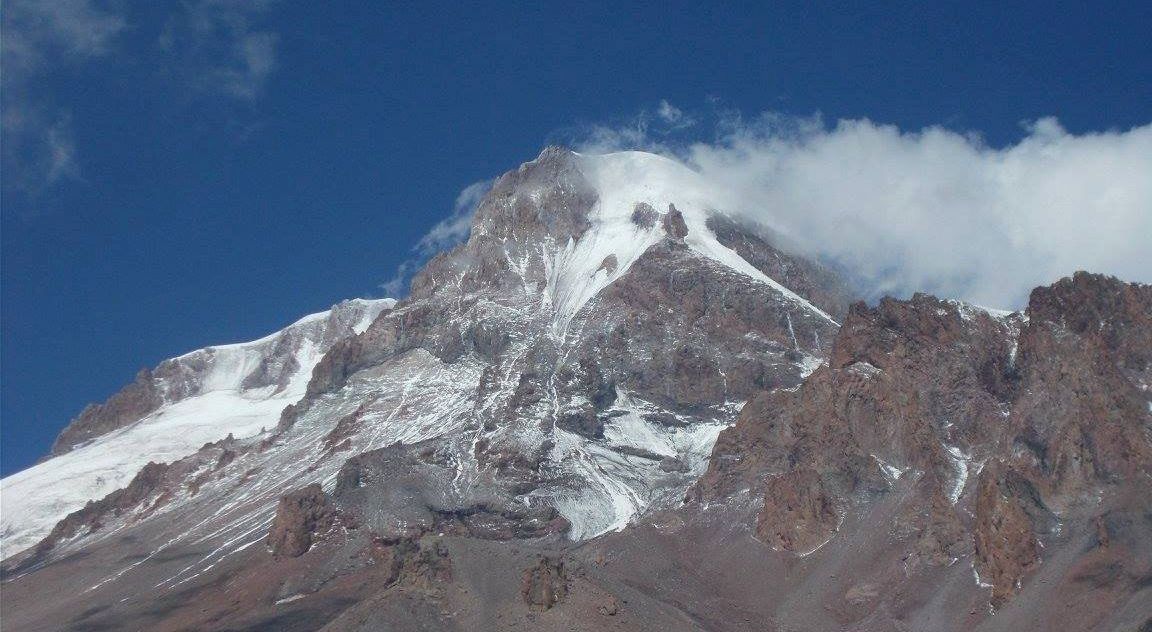
To strive….to seek….to find….and not to yield
I briefly woke up and looked out of the window into the drizzly rain. Jvari Pass, 2654 metres, said the blue sign outside. Behind and in all directions, there were peaks all exceeding 3000 meters.
Shortly afterward, the car pulled in a small town in a peak-surrounded valley called Stepantsminda just as the rain stopped and the clouds lifted. I got out of the car, put my rucksack on, turned around and saw… Mount Kazbek. The day, the hour, the moment had come. The clouds had lifted and the snow sparkled on the summit in the sunshine.
Following in the fabled footsteps of the Greek legend Heracles, I had also journeyed from far away to climb Kazbek. However, unlike Heracles, my goal was not to rescue Prometheus from eternal damnation, nor even to look through the surrounding foothills for the golden fleece.
My task was far different. I was going to go higher than a Caucasian eagle could go, I was going to go higher even than the Golden Fleece could be carried. I was going to attempt to climb all the way through ice, rock, snow, glaciers, crevasses, blizzards, fog and freezing temperatures to the summit of Mount Kazbekat 5047 meters. So what happened…read on …read on….

Day 1
And through the drifts the snowy clifts
Did send a dismal sheen:
Nor shapes of men nor beasts we ken —
The ice was all between.
The ice was here, the ice was there,
The ice was all around:
It cracked and growled, and roared and howled,
Like noises in a swound!
10.25 Warsaw airport. Plane cancelled, what will I do? I must be in Stepantsminda in 36 hours! After racing to get my bags I managed to book myself on a plane to Tbilisi via Kiev. I got to Tbilisi 20 hours late but still with a little time before I had to journey to Stepantsminda to meet the good folk of Mountain Freaks agency.
After spending the morning checking my gear and buying a few bits and pieces I collected my bags and went to Liberty Square. A car that had spotted me pulled up. Thankfully the landlady had written the address out so I pointed to the paper. “Yes, yes”, the man said, took the taxi sign off the roof and tossed it into the back. A few minutes later we sped in the direction of the station.
Suddenly,a car in front slammed on brakes sharply, forcing my driver to as well. A few beeps of the horn and an acceleration to exchange pleasantries ensured. Then I noticed that the other driver was pointing a familiar metal object at my driver, so I suggested to him that getting me to the bus station on time was both more urgent and safer for him than bothering with the other driver’s weapon.
At the station awaited us typical Georgian bedlam, noise, heat, dust, and chaos. Luckily, there was also a marshrutka waiting for the last passenger and not much later, we departed. The ride to Stepantsminda took around three hours. Since I had to balance on my seat with the two exposed screws, sitting through it was way more challenging than it should have been.
After arriving at the office I collected the carabineers, harness, helmets,crampons, ice axe, sleeping bag, head torch and headed for the booked accommodation. That night myself and the rest of the fantastic five were treated to a traditional Georgian supra with food of all descriptions followed by dish after dish and a pre-climb briefing.
Day 2
Wake alone in the hills, with the wind in your face
It feels good to be proud, and be free and a race
That is part of a clan, and to live on highlands
And the air that you breathe, so pure and so clean
When alone on the hills, with the wind in your hair
With a longing to feel, just to be free
We arose at eight and were picked up by Anya who would be our liaison with the Georgian guide for the following days. The last-minute food shopping done, we drove to the Gergeti Trinity church along an unbelievably rocky dusty track. Here we loaded our gear bags onto the horses and proceeded with our other bags to base camp one at a river approximately 3000 metres above sea level.

Fergal with Gergeti Trinity church
When we got there, we put up the tents and settled down for the night. We got water from the stream nearby and boiled it so we could drink it - a practice which I was going to get very familiar with over the next few days. Soon after, a storm hit. Thunder, lightning, hailstones ensured for most of the night and when it was finally over, a drunk man from another tent tripped over one of the ropes, my tent collapsed and water poured in. So I had to jump into a different tent for the rest of the night with my damp sleeping bag.

Climb to Arsha pass
Day 3
I'm the man on the silver mountain,
I'm the man on the silver mountain
Just look at me and listen
I'm the man,the man,give you my hand
Come down with fire
Lift your spirit higher
I'm the man on the silver mountain
We rose early, dismantled the tents and waited for horses. Then we approached a river which had swelled a lot both from the glacier and the previous night’s rain. We jumped on the horses and with just the saddle to hold onto and no stirrups or reins, it made for an interesting river crossing. Shortly after we arrived at the glacier, put on crampons and headed up the steep slopes taking care to avoid the flowing streams and crevasses that crisscross the glacier. After a 3 km walk, we arrived at the base of the track that leads to the Meteo station.

Mountains beneath the glacier

On the Gergeti glacier

One of the crevasses

On the Gergeti glacier
The Meteo station is located at a height of 3670 metres. It is a very rudimentary building with very basic facilities and no running water, but with a stunning view of the glacier below. There were tents scattered in all directions and two yellow tents for the Polish mountain rescue service who are there on a voluntary basis.
One of the first things you notice at this height is that most of the lighters don’t work. In the kitchen area, jetboils were working everywhere as people were pouring their boiled water into readymade meals. The most common thing you heard was “are you making chai” (tea) or “have you fire that works”.
Another storm swept in that night and there were only nine groups heading for the summit. They generally leave between two and three in the morning. Due to strong winds and poor visibility, only two out of the nine groups summited that day.

Former meteostation Betlemi hut

Fergal at Betlemi hut

Views from Betlemi hut
Day 4
I've got to be strong
Oh, I'm falling off the edge of the world
Think you're safe, but you're wrong!
We are falling off the edge of the world!
In some respects, despite the squalor around, the Meteo station is a remarkable place. There are climbers from all over the world, the atmosphere is friendly and there are many questions about gear, what other big ones you have climbed it etc. That makes it quite wonderful. It is generally accepted that only 50% of climbers who get to the station make it to the summit. Can we do it? Providence will tell in a few days.
Around mid-afternoon, we climbed up to 4000 metres to acclimatize. There is a small metal chapel which can have 4 people in it at any one time. This structure is fixed to the ground by large steel cables. We stepped over them and sat in the sun for 40 minutes to acclimatize. We were due to climb the following day but as the forecast was bad, our glacier walk skills would be put off till the following day.
All day long, the battered groups made it back down from the mountain at various stages. One Spanish group of three told me that the winds were not 60 KPH as forecast but at least 70 KPH. They also said the visibility on the plateau was at zero. Once again, I wondered will the weather be okay.

Detail of the Gergeti glacier

The chapel

Meteostation seen from the chapel














